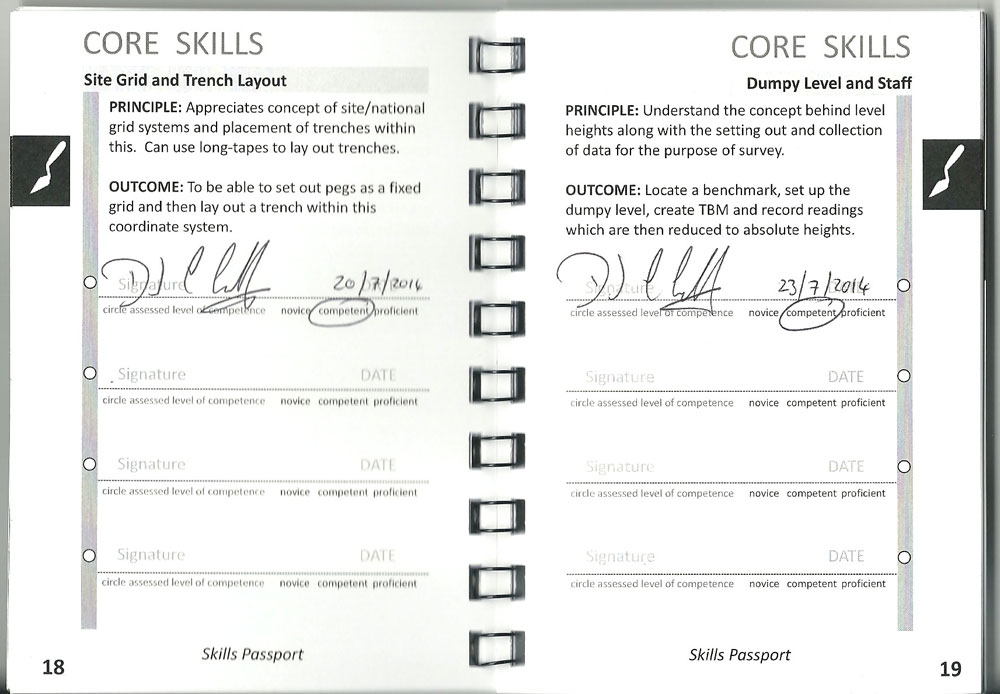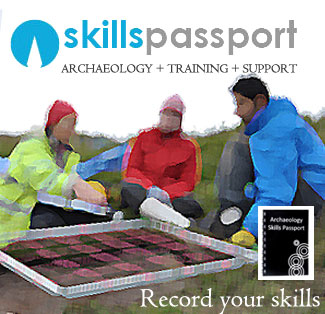
Core Skills – Secondary Skills – Tertiary Skills
A downloadable pdf is available by clicking: Trainer Questions PDF
Handtools (Trowel etc)
Why do you use different tools?
Watch them use these tools and correct them during training. Is there improvement?
Handtools (Spade, Mattock etc)
Why do you use different tools?
Watch them use these tools and correct them during training. Is there improvement?
How high do you swing a mattock?
Why do you not shovel behind you?
How full should a bucket or wheelbarrow be filled?
Site Formation Processes
Name 3 types of formations.
What would make you think the process was natural rather than man made?
Why is understanding the taphonomic pathway important?
Explain how site formation processes can create “missing” phases.
Stratigraphic Excavation
What is the difference between stratigraphic and level spits?
Create a simple section drawing with a pit and get them to describe the stratigraphy.
Can they create a simple Harris Matrix?
Context Sheet Recording
Get them to fill in a context card
Ask the individual to describe a soil or a cut.
Ask the individual to discuss the context.
Site Photography
Ask them what are the basic requirements of a site photograph (lighting, scales, recording)
How would they deal with sunny weather and deep shadow? – Why is that bad?
Get them to explain how ranging rods are set out and where T- and L-shapes
Why is direction important? What is required on a record sheet?
Site Grid and Trench Layout
What is a 3x4x5 triangle
What is the diagonal of a 1m, 5m and 10m grid?
Ask what a local grid is and how it can be related to real coordinates.
Dumpy Level and Staff
Where will you find a Bench Mark
How do you find out the height of the Instrument?
Take at least 5 foresight measurements then reduce the levels.
Planning
Ask for the details that are required on every drawing – ( Drawing Number, Scale, North Arrow, Grid points, Date, etc)
Ask if notes around a drawing are useful and if so … why?
Look at a sample drawing – are the lines confident or short and sketchy.
Section Drawing
Ask for the details that are required on every drawing – ( Drawing Number, Scale, Orientation, Grid points, Date, etc)
Ask if notes around a drawing are useful and if so … why?
Look at a sample section drawing – are the lines confident or short and sketchy and are they angular – with a join the dots look?.
How do you set up a section line?
Collection of Samples
What sort of samples might you collect? ( Bulk, Spot, C14)
How would you label a sample?
What may prompt a sample?
Artefact Recovery, Recording & Storage
What is a small find?
When would you blocklift?
What must be recorded on every finds tray?
How would you store – wet leather – Iron – large quantities of pottery?
Site Safety
Do you know about risk assessments?
Whose duty is site safety?
Do you know who the trained first aider is?
What do you do if there is a reportable accident?
Survey (Total Station)
Are you aware of the basics behind manual survey?
What is the difference between a local grid and a national grid?
Ask them to up over a station, sight on ref obj and ensure they have taken the height of machine, height of staff and entered the correct cords for both the Station and RO
Geophysics
What does (pick the type you are using) detect?
What is the strength of this type?
What is the drawback?
How would you start a geophysical survey?
Landscape Walkover Survey
What information do you need BEFORE going out on Survey.
What basic Equipment would you take?
When locating a site what is the procedure for recording?
Field Walking
What equipment is required on a fieldwalk?
What will a fieldwalk show?
What is the best? Transect or square? (no right answer)
Environmental Processing
What types of processing can you carry out on site?
What material may you recover?
How should you collect and store this material
What can be done with this material?
Finds Processing
What should you wash and what should you not wash?
Ask them about rebagging.
Talk about general sorting of finds.
GIS & Data Management
Where can you find sources of data?
Discuss three options for GIS and database management of data
What is the standard file format?
Data Entry/Archiving
What is the golden rule of data input ( hint… don’t make it up… ask – or highlight)
What is a digital archive?
Excavation and Lifting Skeleton
Watch and access a skeletal excavation and lift – including drawing and record.
Make sure they are aware of damage to bones.
Report and Article Writing
What general order should you create a report in?
What is the difference in language between an article and a report?
Who should be credited in any document?
Illustration and Graphics
Set an example artefact and ask them to draw the item.
Using a vector package, ask them to produce a site plan OR a location plan
Discuss the need for complementing text.
Public Outreach
Is it Them or Us?
Observe interaction with people.
Ask them a typical question (related to where you are) and gauge their response. (should be short, informative and imaginative – OR they should admit to not knowing and will find out.
Heritage Legislation
What is the main heritage legislation for your country?
Who enforces this legislation?
Provide an example case involving a scheduled monument or a listed building – and ask how they would act or where they would go to ask for details.
Do they understand how other legislation (employment and H&S) impacts on archaeology?


